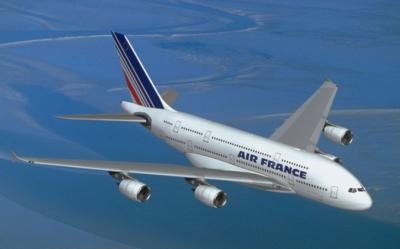Wed, Mar 14, 2012
AIRE Trials Supported By Airbus
Three Airbus-supported projects in the Atlantic Interoperability Initiative to Reduce Emissions (AIRE) have demonstrated how improved ground operations and air traffic management procedures can contribute to reductions in fuel consumption for the air transport industry. One element in this second wave of European AIRE flight trials were the Transatlantic Green Flights, using Air France’s A380 in service between New York and Paris. The focus was on performing two-engine taxi-out procedures for the ground movement phase, and optimising the transatlantic trajectory for the en-route flight phase.

Airbus led the A380 Transatlantic Green Flights activity, working in partnership with Air France and the air navigation service providers from the UK, Canada and the United States. A total of 17 successful trials were achieved, and the predicted combined fuel gain potential of approximately one ton per transatlantic crossing was confirmed.
Another project was Green Shuttle, performed under the French air navigation service provider’s leadership, with Air France and Airbus as partners. By optimizing the lateral and vertical trajectories during all phases of regularly-scheduled shuttle services between Paris’ Orly Airport and Toulouse in southwestern France, it demonstrated improved fuel efficiency through 60 revenue flights.
The Green Shuttle operations were made possible through better coordination among the five involved French air traffic control centers, with 154 lbs. of fuel saved per flight from Orly to Toulouse, and 440 lbs. per flight in the opposite direction. In its contribution, Airbus performed flyability analyses for the Continuous Descent Approach (CDA) into Toulouse and provided recommendations for the optimization of this procedure.
The third element – called the VINGA project – involved the validation of Required Navigation Performance (RNP) arrival procedures with the A320. The Airbus Quovadis subsidiary – which offers services for the implementation of RNP procedures – contributed to the VINGA project, under leadership of the Swedish air navigation service provider, with Novair and Gothenborg Airport as additional partners. VINGA optimized all phases of flight, with an emphasis on the implementation of new RNP arrival procedures. A fuel gain of 48-200 lbs. per segment was measured in the latter phase of over 100 trial flights.
Results of the VINGA project, along with the Transatlantic Green Flights and Green Shuttle, were presented at this month’s Air Traffic Control Global 2012 Conference and Exhibition in Amsterdam. (Image provided by Airbus)
More News
A Puff Of Smoke Came Out From The Top Of The Engine Cowling Followed By A Total Loss Of Engine Power On May 9, 2025, about 1020 mountain daylight time, an experimental amateur-buil>[...]
From 2022 (YouTube Edition): Jenny, I’ve Got Your Number... Among the magnificent antique aircraft on display at EAA’s AirVenture 2022 was a 1918 Curtiss Jenny painstak>[...]
Very High Frequency (VHF) The frequency band between 30 and 300 MHz. Portions of this band, 108 to 118 MHz, are used for certain NAVAIDs; 118 to 136 MHz are used for civil air/grou>[...]
“From approximately November 2021 through January 2022, Britton-Harr, acting on behalf of AeroVanti, entered into lease-purchase agreements for five Piaggio-manufactured airc>[...]
Microburst A small downburst with outbursts of damaging winds extending 2.5 miles or less. In spite of its small horizontal scale, an intense microburst could induce wind speeds as>[...]
 NTSB Prelim: Lee Aviation LLC JA30 SuperStol
NTSB Prelim: Lee Aviation LLC JA30 SuperStol Classic Aero-TV: Curtiss Jenny Build Wows AirVenture Crowds
Classic Aero-TV: Curtiss Jenny Build Wows AirVenture Crowds ANN's Daily Aero-Term (05.30.25): Very High Frequency (VHF)
ANN's Daily Aero-Term (05.30.25): Very High Frequency (VHF) Aero-News: Quote of the Day (05.30.25)
Aero-News: Quote of the Day (05.30.25) ANN's Daily Aero-Term (05.31.25): Microburst
ANN's Daily Aero-Term (05.31.25): Microburst



